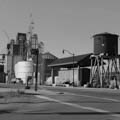The Draper Poultrymen and Egg Producer’s Plant was built for a farmers’ cooperative and is indicative of the formative role of chickens and eggs in the town’s economy during its nascent phase in the early twentieth century. The plant has nine buildings and four structures, built in phases between 1926 and 1974.
Draper was founded as a Mormon farming settlement in the mid-nineteenth century. A couple families began experimenting with raising chickens in the early twentieth century, and the arrival of electricity (1912) and water pipes (1915–1917) in Draper enabled small-scale poultry farming to transform into an industrial enterprise. By the 1930 census, one-third of all farmers in Draper were employed by the numerous chicken farms and egg processing plants. A considerable part of this transformation was made possible by the initiative of eight farmers who, in 1918, set up a cooperative to buy feed and market eggs. This cooperative registered as Poultrymen Incorporated in 1926, and co-owned a plant with the Draper Egg Producers Association. Their eggs sold from California to New York and carried the Draper brand name. In the 1940s, Draper was known as the “Egg Basket of Utah.”
The Draper Poultrymen and Egg Producer’s Plant included a number of facilities: mills, where the feed is prepared; grain bins; warehouses, which held packing, candling, and other farming equipment; offices for management and accounting staff; and a store. Together these spaces represent different aspects of the poultry business as it was practiced and transformed from the 1920s to the 1970s. The plant is a medley of metal silos, concrete ribbons of office space, trailers, lattice poles of all sizes, protruding pipes, and pencil-thin walkthrough bridges and ledges. Voluminous cylinders, some finished in sheet metal and others in corrugated steel, rest beside masonry cubes stacked artlessly on top of one another. On display are the mechanical and structural systems of the plant: cubes and cylinders, flat and pitched roofs, smooth and ribbed surfaces. These create a dynamic composition with considerable depth, and the eye moves ceaselessly between the crisscrossing planes and lines formed by grain tubes, feeding ducts, spiral stairs, ladder lines, scaffoldings, and railings.
In 1963, the plant was sold to its current owners, the Intermountain Farmers Association (IFA). In 1967, an aggressive fire burned the mill and storage plant that formed the center of the complex. It was partially rebuilt the same year and IFA later added two new warehouses, one in 1969 and another in 1974. IFA continues to operate in Draper and serves a much more diversified body of farmers. A new store, located just next door at 1027 Pioneer Road, opened in 2018. The plant continues to dominate the Draper skyline although it no longer controls the economy—Draper is now home to several large companies, including eBay, and growth is expected to continue once the Utah State Prison relocates in 2022 to its new site in west Salt Lake City, leaving its 700-acre site in Draper open for development.
References










